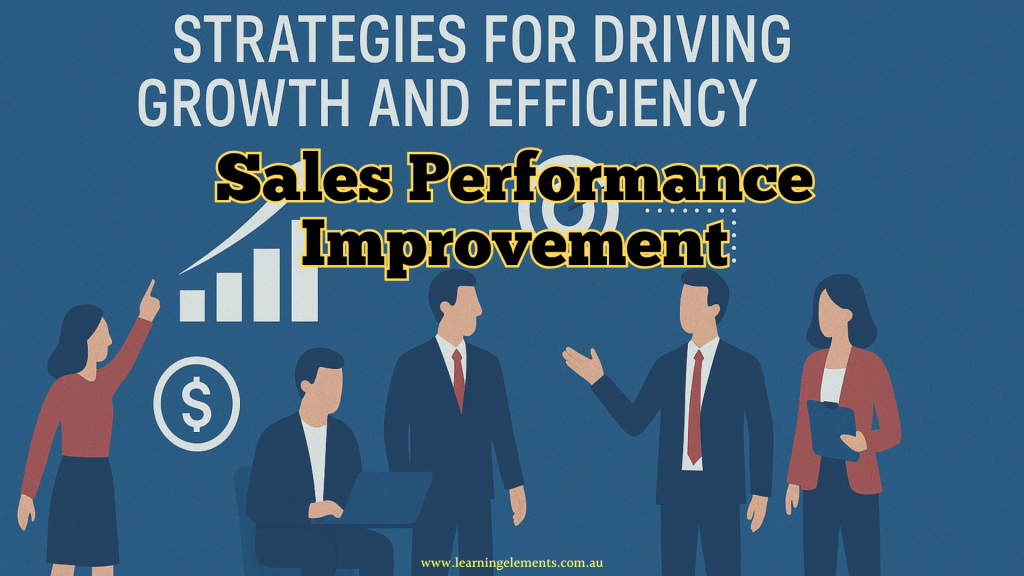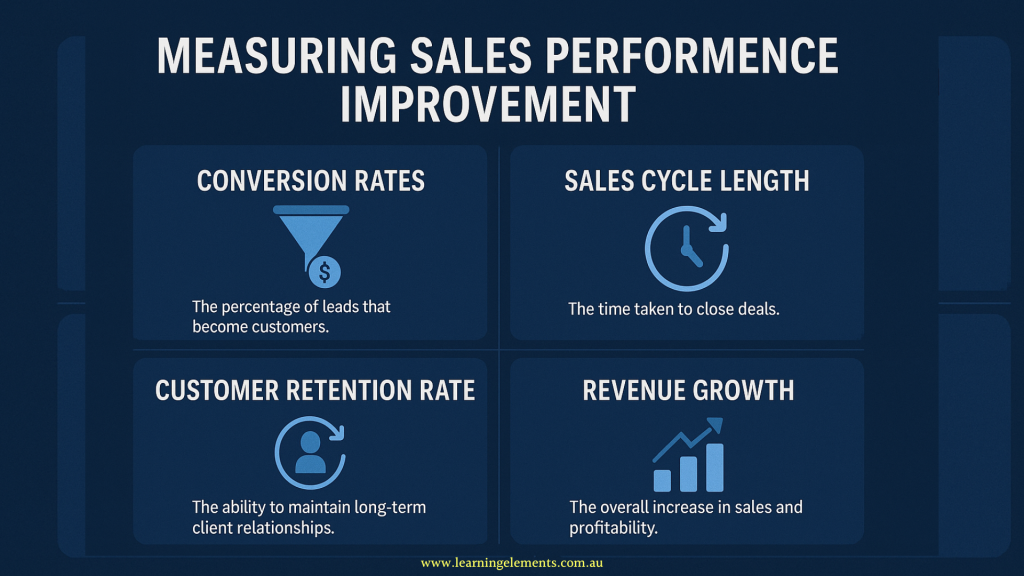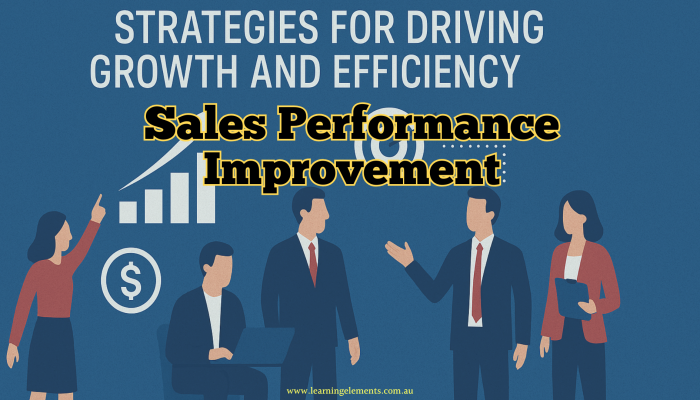Sales Performance Improvement: Strategies for Driving Growth and Efficiency
Sales performance improvement is more than just a business buzzword—it’s a strategic need in today’s fast-paced and competitive market. Whether you’re looking to sharpen your sales team’s capabilities or streamline your sales operations, improving performance at every stage can significantly boost efficiency and long-term growth. With the right approach, organisations can turn their sales functions into high-performing engines that consistently meet and exceed targets. This article explores key strategies and actionable areas for improving sales performance to stay ahead in a fast-paced business environment.

What is Sales Performance Improvement?
Sales performance improvement focuses on enhancing the effectiveness of sales teams, processes, and strategies to drive business growth. It involves:
- Optimising Sales Processes – Streamlining workflows to reduce inefficiencies.
- Enhancing Sales Skills – Training and coaching sales teams for better performance.
- Leveraging Technology – Using data analytics, CRM tools, and AI to improve sales strategies.
- Aligning Sales and Business Goals – Ensuring sales activities support overall company objectives.
Sales performance improvement is not just about increasing sales—it’s about building a smarter, more agile, and aligned sales function.
Key Areas for Sales Performance Improvement
1. Sales Training and Development
Ongoing sales training and coaching help teams develop essential skills, such as communication, negotiation, and customer relationship management.
- Regular workshops, mentorship, and role-playing scenarios can foster continuous improvement.
- Tailored coaching programs for underperformers or newly onboarded sales staff can ensure skill alignment across the team.
Example: A tech company implemented monthly role-playing sessions and saw a 20% improvement in win rates within six months.
Pitfall to Avoid: One-off training sessions without reinforcement often fail to produce lasting results. Use continuous development programs.
2. Data-Driven Sales Strategies
Using sales analytics and performance metrics allows businesses to identify trends, assess effectiveness, and adjust strategies accordingly.
- Sales dashboards and forecasting tools help monitor real-time performance.
- Analysing buyer behavior and sales funnel progression ensures more accurate targeting and messaging.
Example: By analysing CRM data, a retail business discovered its highest-value clients were referred customers, leading to a shift in strategy that boosted referrals by 40%.
Stat: According to McKinsey, companies using advanced analytics see a 5–10% increase in sales productivity.
Pitfall to Avoid: Relying only on lagging indicators (like revenue) instead of tracking leading indicators (like call-to-demo ratios).
3. CRM and Sales Automation
Customer Relationship Management (CRM) systems and automation tools enhance lead management, track customer interactions, and improve conversion rates.
- Automating routine tasks frees up time for more strategic sales activities.
- CRM data helps personalise customer interactions and prioritise high-potential leads.
Example: A B2B service firm reduced lead response time from 2 days to 2 hours by automating lead routing and follow-up emails.
Stat: CRM systems can increase sales by up to 29%, improve productivity by 34%, and forecast accuracy by 42% (Salesforce).
Pitfall to Avoid: Over-automation can lead to impersonal communication—ensure human touchpoints remain in key stages.
4. Sales Process Optimisation
Reviewing and refining sales workflows helps eliminate bottlenecks, reduce response times, and improve overall efficiency.
- Mapping the buyer’s journey can highlight gaps or delays in the sales process.
- Clear documentation and standardisation of sales stages improve onboarding and scalability.
Example: Mapping the buyer’s journey helped a SaaS company identify friction at the proposal stage—revamping their proposal process cut average sales cycle time by 15 days.
Pitfall to Avoid: Ignoring internal feedback from sales reps—those on the ground often know where inefficiencies exist.
5. Performance-Based Incentives
Structured commission plans, bonuses, and rewards keep sales teams motivated and focused on achieving targets.
- Incentive programs tied to KPIs promote accountability.
- Recognition and reward systems also help retain top talent and reinforce a positive sales culture.
Example: A tiered bonus system based on team and individual performance improved collaboration and increased sales by 18%.
Pitfall to Avoid: Incentive plans that are too complex or misaligned with goals can demotivate reps. Keep structures simple and transparent.
Common Challenges in Sales Performance Improvement
Improving sales performance doesn’t come without its hurdles. Common challenges include:
- Lack of clarity in goals: Misalignment between sales and business objectives can stall progress.
- Inconsistent processes: Varying approaches among reps can affect outcomes.
- Data overload: Teams often struggle with too much data but not enough actionable insights.
- Technology adoption resistance: CRM and automation tools only work if teams actually use them effectively.
Addressing these challenges with clear training, strong leadership, and cultural alignment can significantly accelerate improvement efforts.
The Role of Sales Leadership in Driving Performance
Sales leaders play an important role in driving performance improvement. Beyond setting targets, their responsibilities include:
- Creating a culture of accountability and support.
- Providing real-time feedback and coaching.
- Ensuring alignment between marketing, sales, and customer success teams.
- Advocating for the right tools and training to empower their teams.
Strong leadership can boost motivation, reduce turnover, and sustain long-term gains.
Ready to boost your sales team’s results?
Explore our targeted training courses or contact us to design a custom programme that fits your business goals.
Trends Shaping the Future of Sales Performance
Sales performance strategies are evolving with emerging trends, such as:
- AI-driven personalisation: Tools like AI-powered CRMs offer smart recommendations and real-time customer insights.
- Virtual selling environments: With more customers preferring remote interactions, virtual sales techniques are a key competency.
- Microlearning for sales reps: Short, focused training bursts are replacing long seminars to keep reps continuously upskilled.
Staying ahead of these trends can give organisations a competitive advantage in both revenue generation and customer satisfaction.

Measuring Sales Performance Improvement
Businesses can track sales performance improvement through key performance indicators (KPIs), such as:
- Conversion Rates – The percentage of leads that become customers.
- Sales Cycle Length – The time taken to close deals.
- Customer Retention Rate – The ability to maintain long-term client relationships.
- Revenue Growth – The overall increase in sales and profitability.
Tip: Track both individual and team KPIs regularly, and visualise them in dashboards for greater transparency and accountability.
FAQs
1. What is sales performance improvement in business?
Sales performance improvement refers to strategies and actions taken to enhance the effectiveness and efficiency of a sales team. This includes improving sales processes, coaching staff, using data-driven tools, and aligning sales goals with overall business objectives.
2. Why is sales performance improvement important for Australian businesses?
In competitive markets like Australia, improving sales performance helps businesses stay agile, meet revenue targets, and deliver better customer experiences. It’s crucial for long-term growth, especially in sectors like retail, SaaS, and professional services.
3. How can I measure the success of a sales improvement strategy?
You can track key metrics such as conversion rates, sales cycle length, revenue growth, and customer retention. Dashboards and CRM tools are often used to monitor these KPIs in real-time.
4. What tools help improve sales performance in Australia?
Common tools include CRM systems like HubSpot or Salesforce, sales automation software, data analytics platforms, and training tools tailored to Australian business practices and compliance.
5. How often should a business review its sales performance strategy?
It’s best to review your sales strategy quarterly. Regular reviews help identify gaps, respond to market changes, and ensure your team is aligned with business goals.
Conclusion
Sales performance improvement is crucial for business growth. By investing in training, leveraging technology, and refining sales processes, organisations can achieve greater efficiency and profitability. A proactive and data-informed approach empowers businesses to stay competitive, adapt to evolving markets, and unlock the full potential of their sales teams.
A consistent approach to monitoring performance, adjusting strategies, and empowering teams is key. Businesses that continuously invest in improving sales capabilities are more agile, customer-centric, and well-positioned to succeed in changing markets.
Next Step: Make sales performance improvement a quarterly priority. Regularly audit your strategy, tools, and team readiness to ensure you’re always optimising—not just reacting.
How Learning Elements Can Support Sales Performance Improvement
At Learning Elements, we provide customised training and coaching solutions to help businesses enhance their sales performance. Our instructor-led, self-paced, and online training programmes ensure sales teams develop the skills and strategies needed for long-term success.
Want to improve your sales performance? Contact us to discuss a tailored strategy for your team.
Sources:
- Salesforce.com: 6 steps to improving your business performance with Salesforce
- McKinsey: Unlocking the power of data in sales

